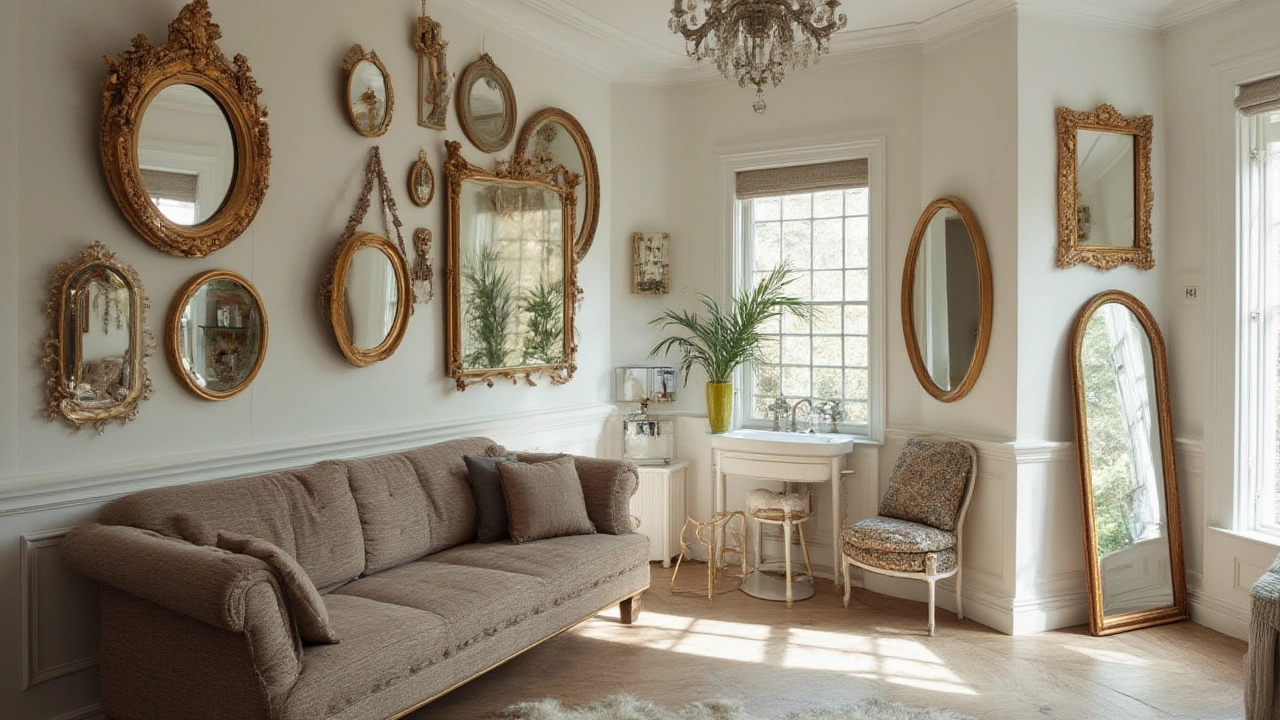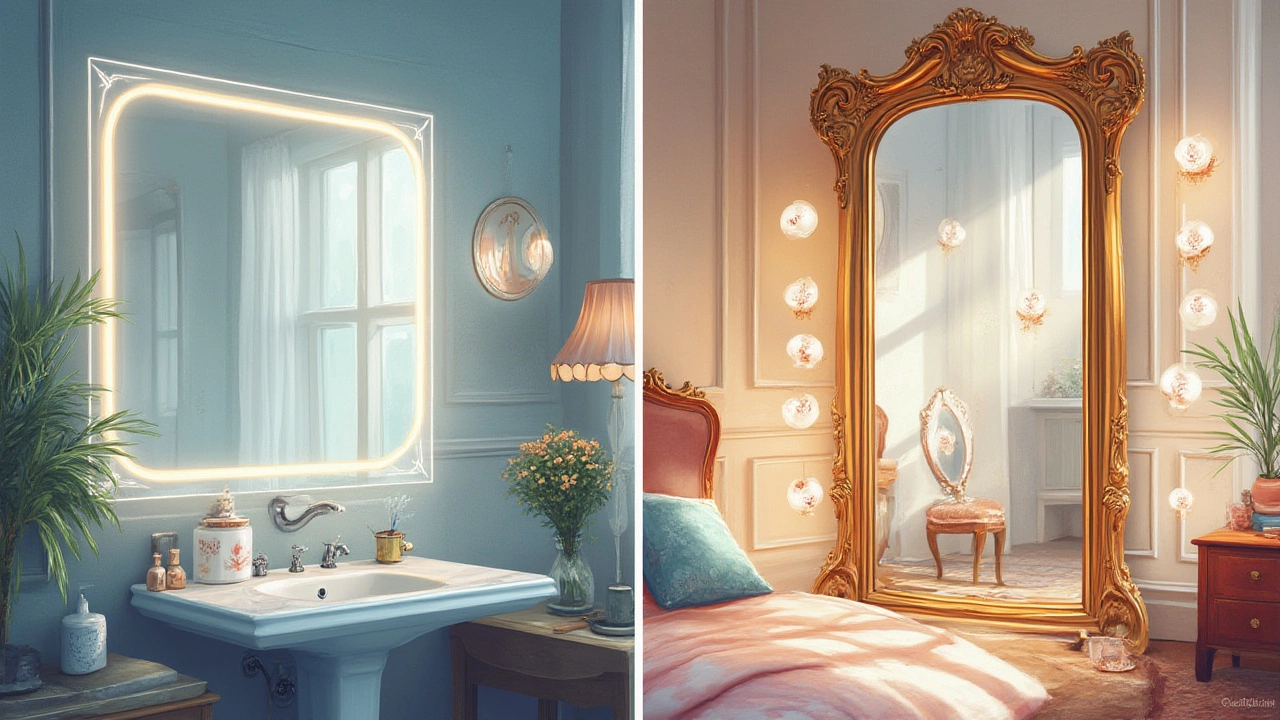Best Mirror Types for Home: From Bathroom to Bedroom Glass Choices
 Jul, 7 2025
Jul, 7 2025
Did you know humans have been making mirrors for over 8000 years? The shiny obsidian ones from ancient Anatolia weren’t much for selfies, but you can bet they made a splash in the mud-brick houses of the day. Fast forward to 2025, and there’s a sea of choices—maybe too many. Oval, round, beveled, tinted, anti-fog, smart—figuring out the best mirror for your space is a legit headache. Don’t let all that reflection confuse you. Instead, let’s clear up which type of mirror is actually best, when to use it, and what makes one glass better than the other.
The Science Behind Mirror Types: How They Work and Why It Matters
Here’s something most folks never think about: the physics behind mirrors directly shapes how you see yourself, and even how your space feels. The classic wall or dressing mirror is a plane mirror—completely flat. That means what you see is what you get, with no warping. But convex mirrors, which curve outward like a dome, shrink and spread out the reflection. Car side mirrors use these to help drivers see more, but they make objects look farther away. On the flip side, concave mirrors bend inward, acting like a spoon—get close and your face balloons; step back, and they flip your image upside-down. Weird but true.
Most mirrors in homes are glass, coated at the back with aluminum or silver. Silvered glass mirrors became the standard in the 19th century, and the process hasn’t changed much. But not all glass is equal. Cheap mirrors sometimes use thin, fragile glass and poor-quality backing, which can distort your reflection over time. High-quality mirrors, like those labeled as copper-free or using thicker glass, are less likely to “go cloudy” or get black edges from corrosion. If you live in a humid area like I do (and Elena’s always fussing about bathroom mirrors fogging up), you’ll appreciate that small upgrade after only a year or two.
And here’s a smart tip: some mirrors are now made with added coatings to resist fog (think bathroom mirrors), or with tints that reduce glare or add privacy (like smoky or bronze decorative mirrors). Newer smart mirrors even combine LED lighting, Bluetooth, or anti-bacterial surfaces—handy and a bit sci-fi.
- Plane mirrors: Flat, undistorted image. Standard for most indoor use.
- Convex mirrors: Domed for wide-angle view, often found in security and automobile use.
- Concave mirrors: Curved inward for magnification, used in makeup mirrors or shaving mirrors.
- Anti-fog or smart mirrors: Extra coatings or tech features, good for modern bathrooms.
Mirror Placement: Picking the Right Glass for Every Room
If you just grab the nearest mirror off a hardware store shelf, you might regret it later. Let’s break it down by room. Bathrooms usually need something that’s water-resistant and holds up against humidity. Frameless, beveled-edge glass in a plane style is common, but if you do detailed makeup or shaving, a double-sided magnifying mirror (concave) on an extendable arm is a real game-changer. If there are kids zooming around, safety glass or acrylic mirrors are smart—no sharp shards if things get rowdy.
Bedrooms and dressing areas want bigger plane mirrors, ideally floor-length, so you can see your whole outfit. Interior designers say mirrors opposite windows make rooms look way bigger—not just a trick of the eye, but actual reflected daylight bouncing around and brightening your space. Here’s a fact: In a study of apartment dwellers in London, 80% said a wall-mounted or sliding-closet mirror made their rooms feel at least a third more spacious.
Entryways love a stylish accent, so circular or geometric decorative mirrors score high for style points—and catching yourself for a last-minute hair check. Kitchens and dining rooms? More folks are adding mirrored backsplashes. They’re easy to clean, but go with thicker, backed glass to avoid scratches and marks from splashes. One tip from Elena: Place mirrors away from stovetops or anything greasy—cleaning gets old fast.
For home gyms, go huge. Wall mirrors or multi-panel setups work best for tracking posture. Studios typically use 6mm thick glass, which is less likely to warp or flex. If you’re DIY’ing, check for reinforced mounting points—mirrors weigh more than you think.

Choosing Shape, Size, and Frame: It’s Not Just About Looks
Shapes make a difference, both for style and function. Rectangular mirrors are everywhere, but round or oval mirrors can soften a space, make walls look less “boxy,” and draw focus. Geometric and abstract designs—think hexagons or layered combos—are trending, showing up in Instagram home tours everywhere. But always measure your wall and sightlines. Too small and it looks tacked on. Too big in a tight space can be overwhelming.
Size matters. A good rule for bathrooms: Pick a mirror that’s about two to four inches smaller than your vanity on either side. For bedrooms and living rooms, bigger is usually better, unless your space is super tight. If you’re filling a wall, floor-length mirrors (at least 48 inches tall) let you see head-to-toe, while medium mirrors (about 30x40 inches) work great over consoles or dressers.
Frames are everything for mood. Sleek, frameless glass feels modern and airy, while chunky wood or metal frames anchor a room and add warmth. Here’s something a lot of folks learn the hard way: If your mirror will get a lot of sunlight, avoid dark wood or unsealed metal, as UV rays and moisture can warp or rust the frame over time. Painted or sealed edges last much longer.
Decorative mirrors double as art. Etched glass, colored tints, or vintage designs don’t just reflect—they draw the eye and set the vibe. My mom always hung antique mirrors in entryways, convinced they “welcomed good luck”—a superstition rooted in Victorian homes. Whether you buy that or not, a unique frame will get way more attention than another plain square.
Quality, Materials, and Longevity: What to Really Look For
If you’ve been frustrated with foggy mirrors or mysterious black spots creeping around the edges, it usually comes down to quality. The best mirrors today use copper-free coatings, which don’t corrode as fast as traditional silvered versions. Thicker glass—5mm or even 6mm—is less prone to flexing and “funhouse” distortions. Safety backing is a must for big, wall-mounted types.
The choice between glass and acrylic is real. Acrylic mirrors weigh about half as much and won’t shatter, making them a solid pick for kids’ rooms or rental apartments. Here’s the catch: Acrylic scratches easier and distorts over wide spaces. For any mirror bigger than a poster, stick to real glass. For smaller, decorative mirrors, you can get wild with acrylic—you’ll have fewer worries about drops.
Check details like edge treatments. Beveled edges are sliced on an angle, catching the light for a fancy touch. Polished edges are smooth but straight. Cheaper mirrors sometimes “swallow the frame” because the reflective layer isn’t painted all the way to the edge—blackening or peeling happens much sooner.
If you’re worried about mirror weight, use a mounting system rated for double the weight of your mirror. Find the wall studs when installing big panels. My brother cracked a dresser-top with a leaning mirror that was meant for wall-mount only, so don’t repeat his mistake.
Here’s a table of quick facts people never ask at the store—but should:
| Feature | Why it matters | Best for... |
|---|---|---|
| Copper-free backing | Slower to discolor, lasts up to 30% longer | Bathrooms, kitchens |
| 5mm+ glass thickness | Less fragile, fewer distortions | Large wall mirrors |
| Tempered safety glass | Won’t shatter in sharp shards | Public spaces, kids’ rooms |
| Anti-fog coating | Reduces fog after showers | Bathrooms |
| Smart mirror | LED, Bluetooth, more features | Modern homes |

How to Pick the Perfect Mirror for Your Needs
Start with purpose and location. Are you framing a fireplace, doing daily makeup, checking gym form, or trying to brighten a gloomy corner? Be honest about what matters. Lighting is huge—mirrors opposite windows multiply daylight on dark winter days. For small apartments, mirrors really do create the illusion of space. Interior designers often recommend grouping a few small mirrors instead of a single massive one if you’re working with an awkward wall.
- If you worry about privacy, like for home offices, experiment with tinted or frosted options. Even a subtle smoky glass can add style and cut distraction.
- For the best best mirror for bathrooms, go with tempered, anti-fog options mounted securely to avoid mishaps.
- If you want a statement piece in the living room, hunt for vintage or arty decorative mirrors with character—local flea markets are treasure troves.
One last thing: Don’t skimp on installation. Screws should go into studs, not just drywall, or use wall anchors at a minimum. If you ever feel unsure, call in a pro—mirrors are heavier and sharper than most people realize. Trust me, even I had to get Elena’s help getting our bathroom mirror level after three tries (she nailed it in five minutes).
So, what type of mirror is really best? It depends on you. But if you want durability, clear reflection, and style, go with a good quality plane glass mirror, copper-free and at least 5mm thick. If you have special needs—privacy, fog-resistance, or modern tech—there’s a mirror out there to fit every nook, style, and budget. Just don’t settle for the first shiny rectangle you see.